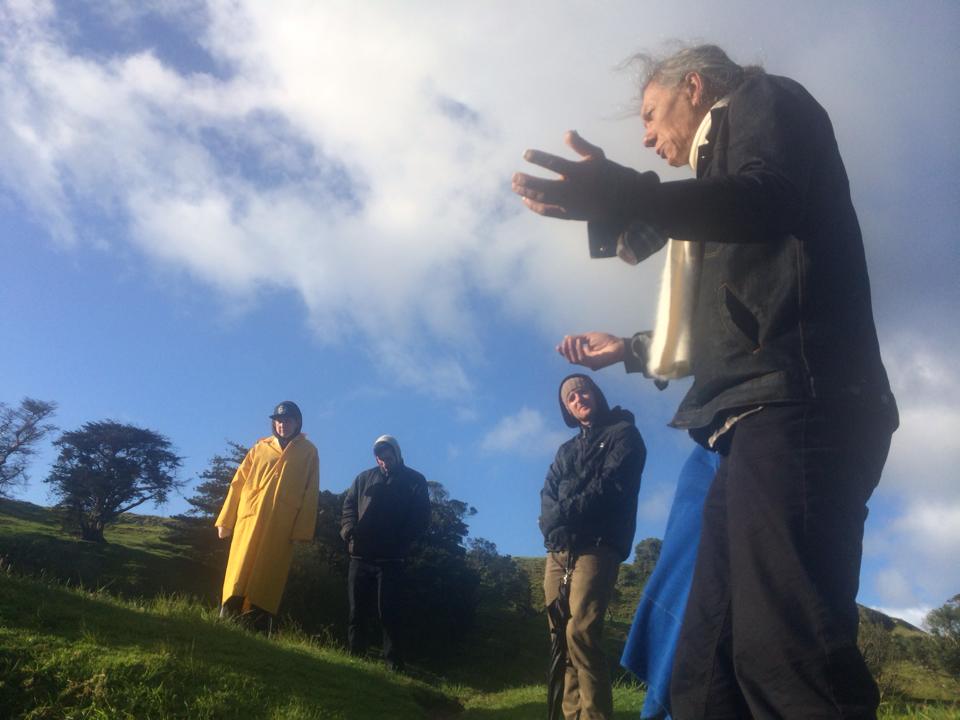A multi-platform research inquiry into naming practices at the St Paul Street gallery, AUT University, Auckland.
Most events ran 21st April to 11th May, Reading Group ran from 16th April
Local Time are a collective of artists, writers and teachers who have facilitated site-specific art projects and events with a specific emphasis on local and indigenous knowledge. Investigation of naming and framing across multiple histories has underpinned much of their work.
While our previous projects have taken shape outside the gallery, our four week inhabitation of Gallery Two at St Paul St (16th April – 11th May 2012) investigated the site of this university-based gallery that sits above Ngā Wai o Horotiu, “the waters of Horotiu”, a name traditionally given to the Queen Street area and the gullies that are bounded by Auckland University of Technology and The University of Auckland.
Taking the question of naming as our theme, we developed a multi-disciplinary, practice-based research investigation with a wide range of collaborators, using the gallery as a site for display, discussion, and hospitality. The project aimed to to involve the artistic and academic communities that are part of the gallery’s audience, increasing all participants’ knowledge of the site while also opening a range of questions about the role of the gallery in the colonial university and our own positions as practitioners, teachers, and publics between “educational” and “cultural” institutions.
Local Time’s methods take a measure of the daily rhythms of where we are working, and the values and practices that determine them. Working “at work” this time, within the university and the gallery, we found ourselves on a familiar kind of contemporary “local time”: one that involves early starts and late finishes to combine making art and making a living.
The actions, public events and more intimate gatherings that made up Local Time: Horotiu are as follows
* A 1994 Toyota Hilux Ute was re-registered as “ARTUTE” the day before the Local Time project commenced. The ARTUTE enabled the relocation of the Suite Seven Collective’s 14 custom-covered mattresses and floor mats from Artspace to St Paul St Gallery Two, for use during screenings, panels and workshops.
* The gallery was used as an base for a student-led project to initiate a student group for Māori and Pasifika AUT art and design studients. Cora-allan Wickliffe and Morgan Tahapehi served over 100 guests in the gallery atrium in their “Fry For Kai” project supporting students on campus.
* Water was collected daily from Te Wai Ariki spring near the Auckland Law School to share with reading group participants and other guests. Each morning began with a reading group on Gayatri Chakravorty Spivak’s An Aesthetic Education in the Era of Globalization. See the site for this reading group here: https://local-time.net/spivakreadinggroup/
* Tuesday evenings featured an open discussion of the project, clarifying our intentions methods and discovering more about the knowledge of the site held in the school and community.
* Later in the evening on Tuesdays three screenings were held:
- The Hornsey Film (dir. Patricia Holland), a 60-minute 1970 film re-creating and reflecting on the student-led occupation of the Hornsey College of Art, May and June 1968.
- Bastion Point: The Untold Story (dir. Bruce Morrison), a 44-minute 1999 documentary on the 1977/78 occupation of Takaparawhau/Bastion Point led by the Orakei Māori Action Committee. This screening was was graced by the attendance of Poppy Hawke, co-producer Sharon Hawke and photographer John Miller.
- Waka Huia, Series 2010/2011, Episode 21 | Nga Wai o Horotiu – a 59-minute documentary on the development of Nga Wai o Horotiu, the marae at Auckland University of Technology in the heart of Auckland’s CBD..
* On Thursdays, two panel discussions were held:
- On 3rd May a panel on contemporary Maori public art featured Carin Wilson, Desna Whaanga-Schollum, and Layne Waerea. It was accompanied by a titi (muttonbird) boilup and brisket boilup.
- On 10th May a group heard of stories and oral histories of what staff and student life has been like in the past at the local art schools of Elam, AUT (and ASA), and reflections on the pacing and timing of teaching and learning between then and now.
* On Saturday 28th April Local Time performed a boat action on the Waitemata Harbour, flying banners and flags from the Mahi Kai thundercat in support of the Aotearoa Is Not For Sale hikoi.
* The climax of the occupation was a party on Wednesday 9th May. For the work Two Hour Opening, AUT Facilities were commissioned to uncover three manhole covers on the concourse directly in front of the Gallery Two window, providing a view of some of the waters underneath. The ARTUTE did duty as a chilly bin, cooling the beer in gallery one while a BBQ was served.
* Jonty Valentine contributed his Risograph machine to make a number of posters during the exhibition which are gathered in this publication. Taarati Taiaroa and Nell May have worked with the documentation of the show for the online platform http://www.elevatorcopy.org
Throughout all these events, a continuous stream of archival research into the history of the site was undertaken by Taarati Taiaroa and shared in the gallery space. This material, combined with information gathered during the other events, led to the development of a text written for the gallery’s written profile information, providing additional layers to the name St Paul Street and the history of its location. This text has been installed on the St Paul Street gallery website: http://www.stpaulst.aut.ac.nz/gallery-information/about-the-gallery
Local Time are Danny Butt, Jon Bywater, Alex Monteith, Natalie Robertson. We acknowledge the generous support of all who participated, and thank the St Paul St staff for the invitation to work in their space.
Please follow our Twitter feed and see our page on Facebook for more information.

















































